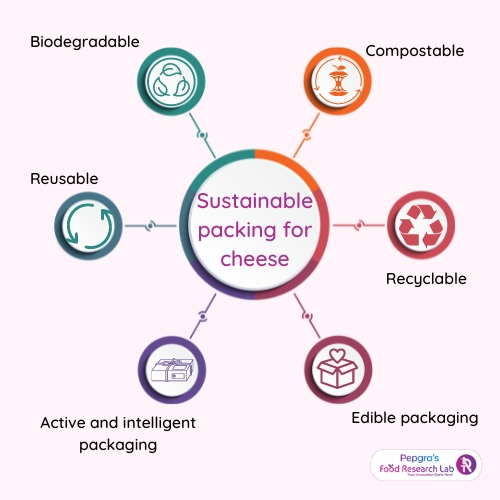
What is the different sustainable packaging for cheese?
Introduction
Since its invention, plastic has been the most prevalent packaging material in the food industry. Plastic has better mechanical properties like flexibility, weight, and mechanical resistance than other packaging materials like glass and wood. Milk products are usually packed in plastic. However, concerns about the health and environmental impacts have been raised since plastic has the propensity to interact with its contents, which can cause health issues and are non-biodegradable. Therefore, there is a growing interest in sustainable food packaging materials that reduce the environmental impact due to plastic [1]. Sustainability in the packaging sector of the food industry has been gaining importance for a few decades, evident from the applications, contributions and literature that discuss its prospects.
Sustainable packaging materials for cheese
The paper “A sustainable cheese packaging survey involving scientific papers and patents”, published in the Journal of Cleaner Production, lists several sustainable packaging options for cheese. Some of these options include:
Biodegradable packaging: Biodegradable packaging made from plant-based plastics or paper can help reduce waste and environmental impact. Biopolymers are materials that can be produced from biomass or microorganisms. The packaging that are high in protein have shown excellent mechanical properties and can also be used as edible packaging. In some cases, agriculture feedstocks are the precursor for biopolymers. Biodegradable packaging can be used in Modified Atmospheric Packaging (MAP) and organic food. However, research is needed to improve the mechanical properties of biodegradable food packaging [2, 3].
Compostable packaging: Similar to biodegradable packaging, compostable packaging breaks down into organic material that can be composted and used as fertilizer. The most important requirement is that all the packaging components must be compostable to render the packaging material compostable [2, 4].
Recyclable packaging: Packaging made from materials that can be recycled, such as glass, aluminium, and certain plastics, can be reused and reduce waste. Recycled plastic can be incorporated into the packaging in the form of nanocomposites and nano additives, and it has a scope to reduce plastic waste in the environment[2, 5].
Reusable packaging: Reusable packaging has risen from the need to reduce waste generation as a part of the 3R, Reduce, Reuse, Recycle. Materials such as glass jars or metal containers can be used multiple times, reducing the need for disposable packaging. In addition, the packaging material can be returned to the supplier in reusable packaging. However, more research is required to substantiate the applicability of reusable packaging. [2, 6].
Active and intelligent packaging: These types of packaging incorporate materials that can help extend the shelf life of cheese, reducing food waste and the need for additional packaging. They also protect consumer health by informing them about chemical and biological changes that lead to food spoilage. For example, research on Furcelleran as an active packaging component on a savoury ingredient like cheese was undertaken. The results showed it has significant antimicrobial activity in gouda and quark cheese [1, 2].
Edible packaging: Edible packaging has risen from a need to replace petrochemical-derived packaging since the environmental damage caused by plastics has become immeasurable. It is made from seaweed, or starch can be eaten with cheese, reducing waste and environmental impact. Edible packaging also allows pigment integration, along with aromatic compounds and vitamins, improves the sensory properties with the help of additives, reduces moisture and flavour loss, and helps stop browning reactions. They also contain proteins, carbohydrates and lipids. Proteins render mechanical properties; carbohydrates control the movement of gases, and lipids control humidity [2, 7].
Overall, the paper highlights the importance of reducing waste and choosing packaging materials that are environmentally friendly and sustainable. The specific packaging options recommended will depend on factors such as the type of cheese, storage conditions, and transportation requirements [2].

Conclusion
Sustainable packaging for cheese has risen from environmental and health concerns about using plastic as a food packaging material. Edible, biodegradable, compostable, reusable, recyclable, active, and intelligent packaging are some relatively more environment-friendly innovations. However, more research is needed for the applicability of biodegradable, compostable and reusable packaging materials in the food industry.
How the Food Research Lab can help
The Food Research Lab provides services for packaging, artwork and testing for food and beverage products. It supports innovation in the food industry and helps its clients develop a product that aligns with consumer needs, ensuring that every product created is successful.





